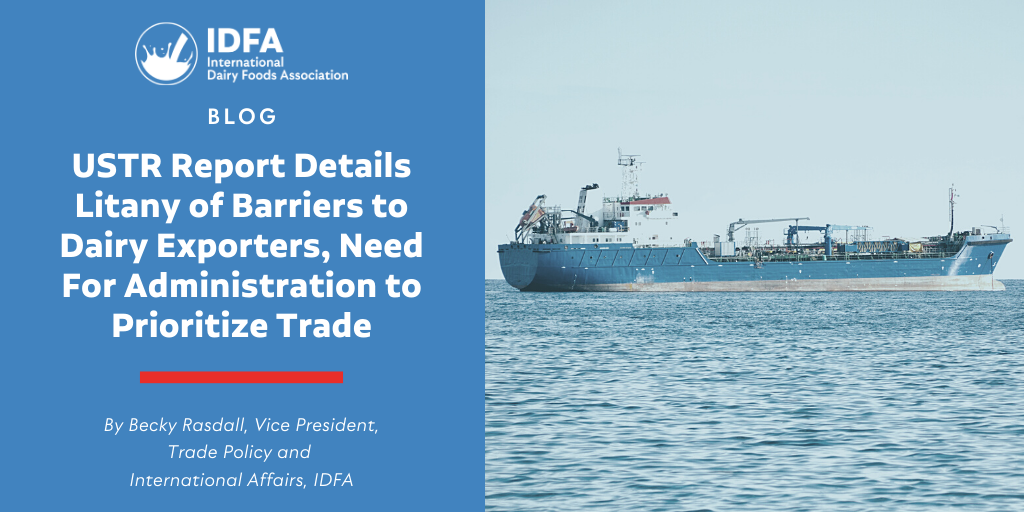The Office of the U.S. Trade Representative (USTR) last week issued its annual National Trade Estimate (NTE) Report, outlining many tariff and non-tariff barriers, including protective measures and technical obstacles to trade. The report includes IDFA’s contributions, which highlight the significant barriers to trade facing U.S. dairy exporters and the need for the new administration to prioritize reducing these barriers.
The National Trade Estimate Report
Published annually, the NTE report details thousands of significant foreign barriers to U.S. exports, U.S. foreign direct investment and U.S. electronic commerce in 65 trading partners and country groups. The NTE is unique in that the United States is one of the only countries in the world that conducts an annual report outlining global barriers to its trade in such a comprehensive manner. Over the years, the NTE has grown from being a report from the administration to Congress to being a compendium for industry stakeholders and a way of putting U.S. trading partners on notice for their barriers to trade and market manipulations.
IDFA Contributions
In October 2020, IDFA submitted extensive comments to USTR highlighting trade impediments the U.S. dairy industry faces in a variety of priority U.S. dairy markets as well as in markets with potential to be priority markets, but which maintain restrictive barriers to U.S. dairy exports. In the comments, IDFA urged the administration to address highlighted tariff and non-tariff barriers facing U.S. dairy exporters in Canada, China, the European Union, and India, among others.
IDFA is pleased to have once again been able to contribute to the NTE—an excellent resource that would not be available without the input of organizations like ours and the incredible efforts of our U.S. government colleagues, who draw on global resources and analysis to publish the NTE annually.
In this year’s NTE, IDFA’s substantive comments on several key industry priorities, including Canada’s TRQ administration or milk class pricing policies, and China’s continued duplicative facility registration requirements, resulted in the U.S. government’s continued monitoring and discussion of these and other barriers with the relevant trading partner.
In total, IDFA’s contributions to this year’s NTE represent almost $2.8 billion of the $6.5 billion dairy products exported globally by the United States in 2020.
Building on the Report
Trade remains a top priority for the dairy industry as we focus on maintaining open export markets that enable U.S. dairy producers and exporters to maximize trade opportunities. IDFA continues to advocate for the protection of existing trade agreements and the development of new trade agreements in order to ensure U.S. dairy products are globally competitive. We recognize the U.S. dairy industry’s needs for equitable and transparent agreements that provide certainty, create preferential access, open markets and eliminate barriers. And we’ll get there by collaborating with the Administration to ensure their consideration of U.S. dairy priorities in all trade negotiations, to provide innovative feedback on dairy trade policy priorities, and by ensuring Congress understands the importance of these agreements to U.S. dairy and the American economy.

Becky Rasdall Vargas
Senior Vice President, Trade and Workforce Policy

